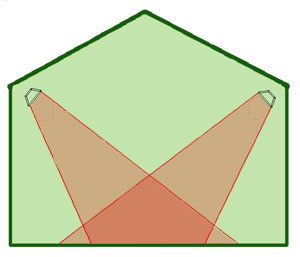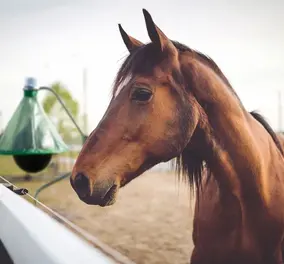Winter is in full swing, the temperature drops and before you know it, your animals are standing in cold stables. Neither you nor the animals are happy about this. How do you make sure your animals stay warm in the winter?
How to make sure your animals stay on temperature?
You can heat your horse in the stable efficiently by bringing the horse up to temperature, not the stable itself. This is done by using infrared heating. The radiant heat does not first heat the air but is directly focused on the animal. In this way, as little energy as possible is lost and your horse is comfortably warm. Infrared heating is also suitable for heat therapy for horses.
Why a normal heater does not work?
Putting a normal heater in the stable will not make you happy. Your horse may be a little warmer, but the warm air disappears through the walls and roof before you know it (unless they are well insulated). As a result, your horse gets minimal benefit from these heaters and you pay a fortune in energy costs.
Installation
In many cases, it is better to install a number of smaller heaters, rather than one or two larger ones, as it is possible to get a better and more even spread of heat. However, you may want to install a ‘spot heating’ system, for drying for example, which you may be able to do by installing just one heater. The first step to designing your new heating system is to calculate the total power output required (in kW).
Calculating the power output required with infrared heaters
The absolute calculation for determining the total size of a heating system is very complicated, as it needs to take into account so many different factors, such as the construction material of the area, the insulation levels and the external and internal temperatures. The calculations below give an approximate power output figures, but you should always bear in mind that the only true way to get the correct size of system is by experimentation.
Step One
Calculate the area to be heated in square meters.
Area (m2) = Length (m) x Width (m)
Step Two
From the table below, select the factor that most closely matches the building type.
Heat load (kW) = Area (m2) x factor
|
Building type |
Multiplying factor |
|
Small building with good insulation or suspended ceiling |
0.08 |
|
Large room or area with good insulation, up to 3 meter ceiling height |
0.1 |
|
Poorly insulated area with high ceiling and concrete floor |
0.15 |
|
Uninsulated building where reasonable levels of comfort are required |
0.2 |
|
General heating in a large building or workshop |
0.25 |
|
Zone heating for an area with little or no heating |
0.45 |
Examples:
A. Small Stable / Tack Room, uninsulated
Size: 3.5m x 3.5m = 12.25m2
Minimum heater output required (factor : 0.15) = 1.8kW
B. Workshop in an uninsulated out-building
Size: 5m x 5m = 25m2
Minimum heater output required (factor : 0.2) = 5.0kW
Positioning the Heaters
Infrared heaters are basically a form of the spotlight, so the energy they produce can be directed in the same way. Carefully positioning the heaters, we are able to effectively eliminate ‘shadows’ from our setup, which would be unheated areas. These can be caused by beams, joists, etc. The greatest benefit is felt when an area is heated from two sides and the beams overlap. For zone heating, infrared radiant heaters should be mounted overhead, angled at 30 to 45 degrees, distributed evenly.
The exact mounting height for the heaters may need to be determined through trial and error due to the multitude of different factors affecting it. However, we recommend that heaters not be mounted lower than 1m or higher than 75cm per 500W plus 100cm, i.e. a 1500W heater should be 2.25m or less and a 2000W heater less than 3m. When mounted at 45-degrees, the spread from a 500W heater will cover approximately 5m2 and each additional 500W a further 3m2 (eg a 1500W heater will cover about 11m2).

Spot heating with infrared heaters
Infrared heaters are well suited to drying water, making them ideal for tack rooms or even drying horses after washing. When using wall mounted infrared heaters for spot heating, the heater can be placed as close as 1m from the surface or animal being heated.
For spot heating, where the heater is mounted directly above the area to be heated, the heated surface is about half the area when mounted at 45-degrees. For spot heating, the minimum power output calculated previously should be multiplied by 2, e.g. if you wish to spot heat an area of 5m2 in an uninsulated stable, we should use a 1.5kW heater:
- 5m2 x insulation factor of 0.15 x 2 = 1.5

Safety precautions for infrared heaters
- Unless IP55 rated, or higher, infrared heaters should not be installed where they will be splashed or exposed to rain. In all cases, try to mount the heater so that the heating elements are facing downwards to prevent a build-up of dust or dirt.
- To prevent overheating an air gap must be left between the top of the heater and the ceiling. We recommend 45cm as a minimum.
- All installations involving 3kW or more must be undertaken by a qualified electrician.
Energy consumption
Infrared lamps are much more economical than the usual heaters and are especially indispensable in stables that are not insulated. The energy consumption of each infrared lamp can vary considerably. A solarium with 24 lamps, each with a capacity of 250 W, will cost you more than 16 lamps of 150 W. However, you do not want to buy a heat source that is too small and does not offer your animal the desired comfort.





